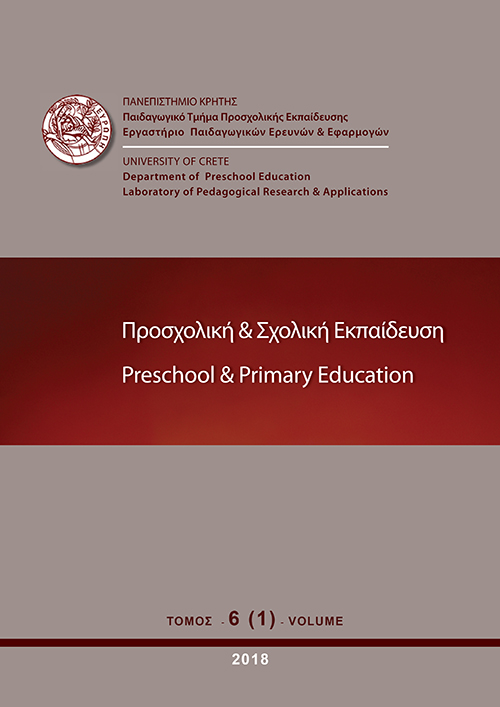Η Επίδραση της Γνωστικής Ανάπτυξης στη Συνεργατική Επίλυση Προβλήματος με τη χρήση του γρίφου Sudoku σε Μαθητές Στ΄ Δημοτικού

Περίληψη
Η παρούσα έρευνα μελετά τη σχέση που έχει η γνωστική ανάπτυξη στην επίλυση προβλημάτων σε δυάδες ή ατομικά, σε μαθητές έκτης δημοτικού με τη χρήση του αριθμητικού γρίφου Sudoku. Στόχος της μικτής αυτής έρευνας ήταν να διαφανεί αν οι μαθητές έχουν καλύτερα αποτελέσματα κατά την επίλυση του γρίφου Sudoku, όταν τοποθετηθούν σε ομοιογενείς ή ανομοιογενείς ομάδες. Συγκεκριμένα, τα ερωτήματα της έρευνας ήταν: πρώτο, ποιος τύπος δυάδας (ομοιογενής ή ανομοιογενής) είναι αποτελεσματικότερος, δεύτερο, όταν τα άτομα εργάζονται ατομικά ποιος τύπος γνωστικής ανάπτυξης επιφέρει τα καλύτερα δυνατά αποτελέσματα στην επίλυση του Sudoku και τρίτο, ποιος ήταν ο βαθμός συνεργασίας των δυάδων. Τα δύο πρώτα ερωτήματα απαντήθηκαν ποσοτικά, ενώ το τρίτο απαντήθηκε ποιοτικά. Στην έρευνα συμμετείχαν 220 μαθητές από 13 διαφορετικές τάξεις της έκτης δημοτικού συμπλήρωσαν το εργαλείο γνωστικής ανάπτυξης Group Assessment of Logical Thinking (GALT), που κατασκευάστηκε από τους Roadrangka, Yeany και Padilla (1983). Στη συνέχεια, 60 μαθητές επέλυσαν τον γρίφο Sudoku ατομικά και άλλοι 160 μαθητές τον έλυσαν σε δυάδες. Ένα από τα κύρια ευρήματα της έρευνας ήταν η μη ανάπτυξη συνεργασίας ανάμεσα στις δυάδες, με αποτέλεσμα οι επιδόσεις στην ατομική ικανότητα επίλυσης προβλήματος να μη διαφέρουν μεταξύ των ατόμων που εργάστηκαν ατομικά και των ατόμων που εργάστηκαν μέσα σε δυάδα στα αντίστοιχα επίπεδα γνωστικής ανάπτυξης.
Λεπτομέρειες άρθρου
- Πώς να δημιουργήσετε Αναφορές
-
Eleftheriou, M., & Christodoulou, N. (2018). Η Επίδραση της Γνωστικής Ανάπτυξης στη Συνεργατική Επίλυση Προβλήματος με τη χρήση του γρίφου Sudoku σε Μαθητές Στ΄ Δημοτικού. Preschool and Primary Education, 6(1), 35–72. https://doi.org/10.12681/ppej.14109
- Τεύχος
- Τόμ. 6 Αρ. 1 (2018)
- Ενότητα
- Άρθρα

Αυτή η εργασία είναι αδειοδοτημένη υπό το CC Αναφορά Δημιουργού – Μη Εμπορική Χρήση – Παρόμοια Διανομή 4.0.
Οι συγγραφείς των άρθρων που δημοσιεύονται στο ΠΡΟΣΧΟΛΙΚΗ & ΣΧΟΛΙΚΗ ΕΚΠΑΙΔΕΥΣΗ διατηρούν τα δικαιώματα πνευματικής ιδιοκτησίας επί των άρθρων τους, δίνοντας στο περιοδικό το δικαίωμα της πρώτης δημοσίευσης. Άρθρα που δημοσιεύονται στο ΠΡΟΣΧΟΛΙΚΗ & ΣΧΟΛΙΚΗ ΕΚΠΑΙΔΕΥΣΗ διατίθενται με άδεια Creative Commons 3.0 και σύμφωνα με την άδεια μπορούν να χρησιμοποιούνται ελεύθερα, με αναφορά στο/στη συγγραφέα και στην πρώτη δημοσίευση για μη κερδοσκοπικούς σκοπούς και με δικαίωμα τροποποίησης μόνον με παρόμοια διανομή (αν αναμείξετε, τροποποιήσετε, ή δημιουργήσετε πάνω στο υλικό, πρέπει να διανείμετε τις δικές σας συνεισφορές υπό την ίδια άδεια όπως και το πρωτότυπο). To Εργαστήριο Παιδαγωγικών Ερευνών και Εφαρμογών του Παιδαγωγικού Τμήματος Προσχολικής Εκπαίδευσης του Πανεπιστημίου Κρήτης και το Εθνικό Κέντρο Τεκμηρίωσης διατηρούν το δικαίωμα να δημοσιεύουν, να αναπαραγάγουν, να παρουσιάζουν στο κοινό, να διανέμουν και χρησιμοποιούν άρθρα που δημοσιεύονται στο ΠΡΟΣΧΟΛΙΚΗ & ΣΧΟΛΙΚΗ ΕΚΠΑΙΔΕΥΣΗ σε οποιοδήποτε μέσο και μορφή είτε μεμονωμένα είτε ως μέρη συλλογικών έργων, για όλο το χρόνο διάρκειας προστασίας της πνευματικής ιδιοκτησίας και για όλες τις χώρες του κόσμου. Αυτό περιλαμβάνει ενδεικτικά και όχι αποκλειστικά, το δικαίωμα δημοσίευσης των άρθρων σε τεύχη του περιοδικού ΠΡΟΣΧΟΛΙΚΗ & ΣΧΟΛΙΚΗ ΕΚΠΑΙΔΕΥΣΗ, αναπαραγωγής και διανομής μεμονωμένων αντιγράφων των άρθρων, αναπαραγωγής ολόκληρων των άρθρων σε άλλη έκδοση του Εργαστηρίου Παιδαγωγικών Ερευνών και Εφαρμογών του Παιδαγωγικού Τμήματος Προσχολικής Εκπαίδευσης του Πανεπιστημίου Κρήτης και του Εθνικού Κέντρου Τεκμηρίωσης και αναπαραγωγής και διανομής των άρθρων ή περίληψης αυτών με χρήση πληροφορικού συστήματος αποθετηρίου.


